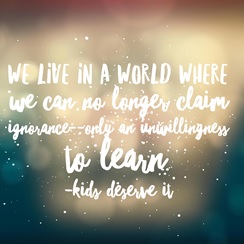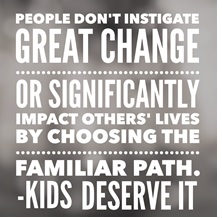Holly Ray is the guest blogger for That Thing You Do! today. She has over 14 years of experience in grades K-12 in both public and private school–nine of those years in administration. I am so grateful that Holly is sharing about the importance of leading others through a change process. You can follow Holly on Twitter @bearbranchelem

Change is hard. Whether you’re a seasoned teacher or a new principal, change is challenging but necessary in order to grow–whether as a professional or as a school. The hardest thing about change is that it almost always involves people. And for the most part, good people. So, how do you lead change when even good people resist?
- Go with the people who want to go. A friend of mine offered some wise words early on in my career. She said, “Holly, go with the people who want to go.” With that being said, I started offering “opportunities” for those who were ready to move forward. My first go at “going with those who want to go” happened when I offered a book study over 17000 Classroom Visits Can’t Be Wrong. I didn’t know what kind of response I would get, but the first day we met almost half of the teaching staff showed up! And not only did they show up, it started a conversation about instruction that others have since joined. Maybe you are thinking about trying something new. Throw it out there and you might be surprised who joins you!
- Remember that everybody has a story. While it’s easy to “go with those who want to go,” the reality is that some people have a backstory that makes change more challenging for them. Fear of losing control, the possibility of failure, and perhaps even the hard work change requires keep many good people from growing. As a leader of change, we must heed Stephen Covey’s wisdom–“Seek first to understand.” Every person has a story and it’s up to us to find out what it is.
- Esteem progress over perfection. If anything can impede change, it’s an expectation of perfection from ourselves as educators. In fact, we have set ourselves up for this kind of mindset. Because we give grades, we are in constant fear of being graded and therefore, if we can’t get an “A” (or do it right), we’re not going to do it at all. Brene Brown, author of The Gift of Imperfection, says, “Perfectionism is not the same thing as striving to be your best. Perfectionism is the belief that if we live perfect, look perfect, and act perfect, we can minimize or avoid the pain of blame, judgement, and shame. It’s a shield. It’s a twenty-ton shield that we lug around thinking it will protect us when, in fact, it’s the thing that’s really preventing us from flight.” We fight change with all of our might because we fear failure, when in reality change is how we–both individually and collectively–reach our full potential and have the greatest impact on our students. We just need to keep taking the next best step…TOGETHER.
- Be authentic about your own learning. This is a tough one (see above). Christy Nockels, a Christian artist, has a line in one of her songs that says, “It’s hard to grow when everybody’s watching.” However, we can’t expect our peers to be brave and take risks, if we’re not willing to do the same. This year, I’ve stepped out and tried new things like a Flipped Faculty Meeting (which turned out to be a success!) and a few other things that were a total flop! I’ve stood before my peers more than once and said, “Well, I’d rather risk it and be wrong than play it safe and never grow.” As a result, I’ve had a few fellow sojourners along the way who have tried everything from flexible seating to flipped classrooms and you know what? The kids loved it!
- Do what’s best for kids–not what’s convenient for adults. At the end of the day, it all comes down to doing what’s best for kids. As Todd Nesloney asks in his book, Kids Deserve It, “How dare we ask our students to show up every day and learn if we’re not learning and pushing ourselves?” And this is where leading change gets really hard. Sometimes, as a leader, you can do all of the above: get to know someone’s story, be authentic and vulnerable about your own learning, and esteem progress over perfection and still be stuck with a good person who is resistant to change. If they’re not willing to grow, then it’s time for them to go because “Schools don’t exists for adults to have jobs. Schools exist for students” (Nesloney).

–Holly Ray










